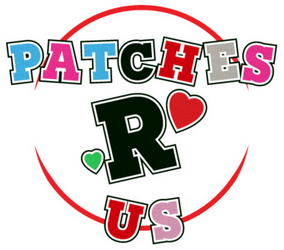
Patch Perfection: Exploring Woven, Embroidered, and Chenille Styles
Let's dive into the world of patch types and explore the unique characteristics of woven, embroidered, and chenille embroidery patches. This guide will help you make an informed choice for your custom project, whether you're upcycling clothing or crafting something entirely new.
Woven Patches

Characteristics:
- Detail & Texture: Woven patches are created using thinner threads, which allows for intricate details and a smooth finish. They are ideal for designs with fine lines and small text.
- Durability: These patches are durable and maintain their appearance over time, making them suitable for frequent use or washing.
- Flexibility: Woven patches are more flexible than embroidered patches, allowing them to conform to the shape of the fabric they are applied to.
Best For:
- Designs with detailed artwork or small lettering.
- Projects where a smooth texture is desired.
- Applications on clothing items that require flexibility.
Embroidered Patches

Characteristics:
- Classic Look: Embroidered patches are known for their classic, textured appearance. The raised threads give them a more traditional and tactile feel.
- Depth & Dimension: The use of thicker threads creates depth, making the design stand out.
- Versatility: These patches are versatile and can be used on a wide range of fabrics.
Best For:
- Designs that benefit from a textured, 3D effect.
- Projects where a traditional patch look is preferred.
- Medium to large designs where detail is not overly intricate.
Chenille Embroidery Patches

Characteristics:
- Soft & Plush: Chenille patches are made with looped yarns, giving them a soft, plush texture. They are often associated with varsity jackets and letterman patches.
- Bold & Eye-Catching: The fluffy texture makes them bold and eye-catching, perfect for making a statement.
- Size Considerations: Chenille requires a larger space, so it's not recommended for patches with finer details or smaller patches under 5cm. However, in larger designs, you can mix embroidery and chenille to achieve the desired effect and detail.
Best For:
- Large designs where the plush texture can be highlighted.
- Bold, simple designs that benefit from a soft, tactile finish.
- Projects where a combination of textures is desired, mixing chenille with embroidery for added detail.
Making Your Choice
When selecting the right patch type for your custom project, consider the following:
- Design Complexity: If your design has intricate details, woven patches might be your best bet. For a classic look with some depth, go for embroidered patches. If you want something bold and plush, chenille is the way to go.
- Size of the Patch: For smaller patches, woven or embroidered options are ideal. For larger patches, you can experiment with chenille, especially if you're looking to mix textures.
- Application: Consider the fabric and the end-use of the patch. Woven patches offer flexibility, while embroidered and chenille patches provide more texture and dimension.
By understanding these differences, you can make an informed decision that aligns with your project's needs and aesthetic preferences. Whether you're adding a personal touch to your wardrobe or designing patches for a team or organisation, choosing the right type is key to achieving the perfect look and feel.
